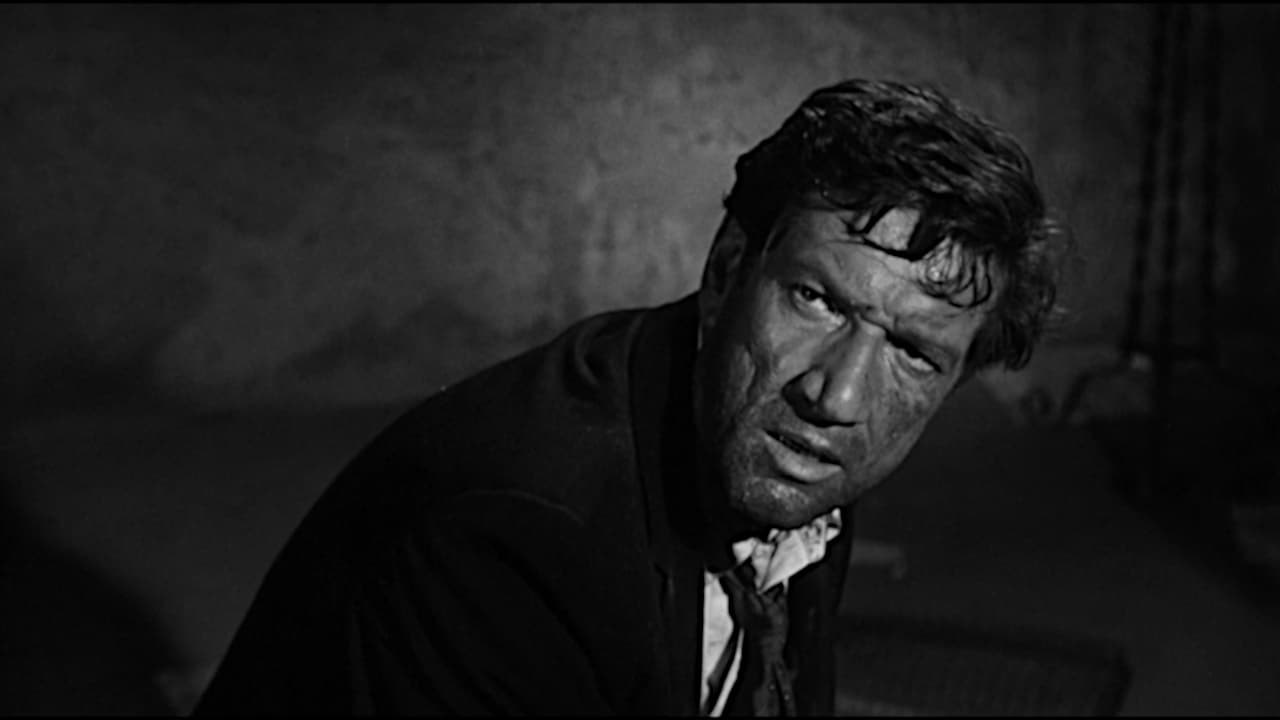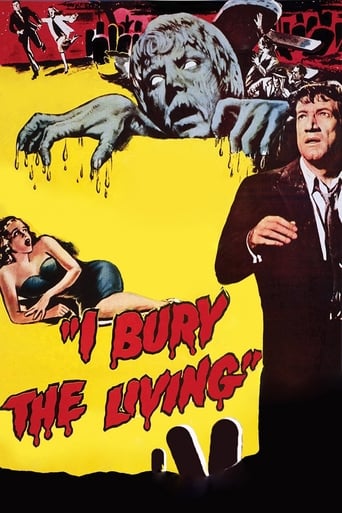

Richard Boone plays Robert Kraft, the newly elected director of a cemetery who finds himself involved in a morbid mystery when people who have plots in the cemetery begin mysteriously dying, especially when Robert realizes that he mistakenly put a black pin(for dead) in place of a white pin(for living) on a big map representing all the burial plots in the cemetery, for people who subsequently died. This doesn't seem to be a coincidence, since every time he does it, someone else dies... Can Robert stop this jinx, or is something else going on here? Theodore Bikel costars as the retiring caretaker Andy McKee. Despite a good score and direction, this film is ruined by the revelation at the end, which is simply not credible, as if it was thought of at the last minute. Too bad, because this could have been good.
... View MoreOn a map of the graveyard on the wall, black pins mean the plot is already "occupied", shall we say. White pins mean the plot is sold, but not occupied. For a laugh one night, the newly appointed cemetery caretaker sticks a black pin into an unoccupied plot. When its owner dies .....Believing it to be coincidental, he does it again: he sticks a black pin into a random unoccupied plot on the map, belonging to W. Isham. We are then introduced to Isham, as he is sticking pins into a stuffed teddy bear, sewing it back together. Creepy, he seems to enjoy it a bit too much, even creepier is when Isham drops dead immediately after that. Surreal images, and tilted and swirling camera-work show the pressure getting to Boone's character, he starts to blame himself for the deaths, and wonders how he can make amends. He decides to remove the black pins and replace them with the white ones.Big mistake.Lack of special effects require the film to focus more on lighting and mood. Zero-budget sets actually help the film, they make the film seem like it could be taking place in any small town, and give the movie a more gritty look. Unique plot hadn't really been done before, or since. This movie is something like The Twilight Zone meets Alfred Hitchcock, harmed only by its ridiculous, cop-out ending, marring an otherwise first class horror.
... View MoreFeaturing a story line worthy of inclusion in the soon-to-premiere "Twilight Zone" TV show on CBS, 1958's "I Bury the Living" would seem to be a natural pick for "sleeper" status, and indeed, the reputation of this minor classic has only grown over the years. Deservedly so? Well, having just watched the film for the first time, I would have to say "yes" and "no." The film is a surprisingly effective thriller for most of its 76-minute length, but unfortunately--for this viewer, anyway--wraps up most disappointingly. More on this in a moment....In the film, the viewer meets the head of the Kraft Department Store, Robert Kraft (extremely well played by Richard Boone), who has just received a piece of bad news from his board of directors: It is his turn, at least for the next year, to be the manager of the town of Milford's Immortal Hills Cemetery. While ensconcing himself in the necropolis' seedy little office and conversing with the groundskeeper/custodian, Andy McKee (Theodore Bikel, a great Austrian actor whose superthick Scottish accent here is just barely understandable), Kraft absentmindedly places two black pins (denoting a deceased and interred resident) instead of two white pins (which denote people who have purchased plots but have not yet expired) near the names of two friends on the large cemetery map. To his great consternation, the couple is killed the next day in a car crash, and when the guilt-ridden Kraft tries the trick again, the same unfortunate thing happens, as one of the cemetery's future residents suffers a fatal stroke. Goaded to try the experiment again and again by his Uncle George and fellow board members, Kraft reluctantly sticks more black pins into the map...with increasingly fatal results! Convinced now that either he or the map harbors some kind of supernatural power, Kraft soon realizes that he might have an opposite ability, as well; i.e., using white pins, he might be able to bring the dead back to life....Intelligently scripted and increasingly suspenseful, "I Bury the Living" benefits from an immensely likable performance from the charismatic Richard Boone. With his homely good looks and naturalistic acting style, is is no wonder that Boone would prove so popular as Paladin on television's "Have Gun, Will Travel," which had premiered the year before and would go on till 1963. The film also features some impressive directorial touches by Albert Band, such as the utilization of extreme close-ups, slow zoom-ins and zoom-outs, and superimposed images. Band makes the cemetery map seem almost like a living thing; in one scene, it glows brightly with an eldritch light; in another, it is shown wavering and shimmering, as if through heat waves; in still another, it seems to grow while Kraft shrinks, almost appearing to swallow him. Kudos must also go out to the film's cinematographer, Frederick Gately, for his wonderful use of light and shadow and overall terrific B&W lensing, as well as to the film's composer, Gerald Fried, whose tinkling harpsichord and blaring horns contribute greatly to the creepy atmosphere. The film also boasts at least two exceptionally well-done scenes. In the first, Kraft anxiously sits by the telephone, waiting to hear of the fates of his three fellow board members, for each of whom he has just stuck black pins into that sinister map; in the second, Kraft attempts to raise the recently deceased using white pins, and runs about the cemetery in the early dawn, to ascertain if they have indeed risen. These are remarkably suspenseful sequences, and it is amazing how much the filmmakers manage to accomplish, and on the smallest of budgets. Indeed, for its first 70+ minutes, "I Bury the Living" must be deemed an unqualified success.And then comes that ending, a wrap-up that is so disappointing in its mundanity that it effectively fritters away all the many frissons that had preceded it. Do you remember the 1935 film "Mark of the Vampire," in which all its supernatural elements are torpedoed at the end by a boring, rational explanation for all the proceedings? Well, it is just such a banal, cop-out kind of ending that we get here. This ending is not only a letdown, but also contradicts and befuddles many of the incidents that had gone before. In an effort to inject an element of realism to his very original script, screenwriter Louis Garfinkle only manages to wreck what had otherwise been a dynamite exercise in the otherworldly. I cannot tell you how disappointed I was by this more-than-ho-hum denouement. Still, I suppose a solid triple is almost as good as a full-fledged home run. On another note, the DVD that "I Bury the Living" currently appears on, from Brentwood Communications, features a very nice print of the film; sadly, however, with no extras to speak of whatsoever. And on the flip side of this disc, for contrast, resides the 1965 Barbara Steele movie "Nightmare Castle." Now THERE'S a film that never copped out on a supernatural finale!
... View MoreI Bury the Living is directed by Albert Band and written by Louis Garfinkle. It stars Richard Boone, Theodore Bikel, Howard Smith, Herbert Anderson, Robert Osterloh and Peggy Maurer. Music is scored by Gerald Fried and cinematography by Frederick Gately.Robert Kraft (Boone) is appointed as the custodian of Immortal Hills Cemetery. On the wall in the cemetery office is a large map that details the plots that are taken by the dead, and the plots that are reserved by other town members. These are signified by black (taken) and white (reserved) pins. When Kraft accidentally places a black pin on the names of living people, he is stunned to find they end up dead shortly after. Coincidence? The title and the fabulous poster art that accompanies it has lured in many a horror fan, only for them to be disappointed with the end product since it's more a mystery thriller with potentially supernatural overtones. A slimline and modest budgeted pic, it's a film that doesn't make the most of the premise at its core. However, there's still a very enjoyable movie here, one that thrives on an uneasy atmosphere and showcases some neat visual, film noirish, touches. Shot in stark black and white to perfectly emphasise the shadowy tension in the plotting, director Band deftly lets the office cemetery map become the dominant force of the piece, marrying it up with the ever fretful Kraft's mental being. These scenes with just Kraft in the cold isolated office are the film's best. Though the outer shots in the cemetery, with tombstones and wrought iron fencing, are suitably eerie too. Boone leads off with a very good performance as a man trying to comprehend whilst doing the right thing, and music and photography is well worthy of our eyes and ears. It could have gone a darker route with Boone's protagonist, while the resolution has understandably infuriated more than it has pleased, but for its unique feel and worthy tech credits it's a better than average time filler. 7/10DVD viewed was French Region 2 release from Bach Movies. Good print transfer but subtitles are not removable and lip sync a problem at times. No extras.
... View More